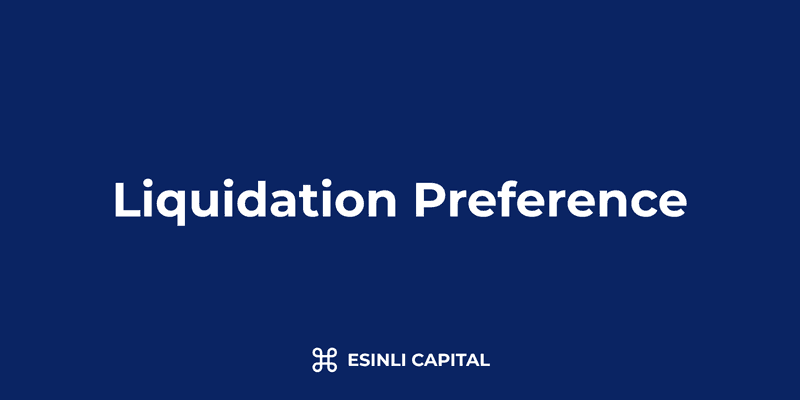In This Article
- What Is a Liquidation Preference?
- Types of Liquidation Preferences
- Multiple Preferences
- Stacked Preferences
- How Exit Waterfalls Work
- Negotiating Liquidation Preferences
- How Preferences Affect Returns in Different Scenarios
- Liquidation Preference versus Dividend Preferences
- Common Liquidation Preference Mistakes
- When Do Liquidation Preferences Matter Most?
- Liquidation Preference: Trends and Market Standards
- The Role of Liquidation Preferences in Acquisition Terms
- Liquidation Preference FAQs
- The Bottom Line
- What Is a Liquidation Preference?
- Types of Liquidation Preferences
- Multiple Preferences
- Stacked Preferences
- How Exit Waterfalls Work
- Negotiating Liquidation Preferences
- How Preferences Affect Returns in Different Scenarios
- Liquidation Preference versus Dividend Preferences
- Common Liquidation Preference Mistakes
- When Do Liquidation Preferences Matter Most?
- Liquidation Preference: Trends and Market Standards
- The Role of Liquidation Preferences in Acquisition Terms
- Liquidation Preference FAQs
- The Bottom Line

Liquidation Preference: Types, Calculations & Negotiation
KEY TAKEAWAYS
- Liquidation preferences give preferred shareholders priority to receive proceeds from an exit event before common shareholders
- Non-participating preferences allow investors to either take their preference amount or convert to common shares, while participating preferences let investors "double-dip"
- Multiple preferences (2x, 3x) increase investor returns by guaranteeing multiples of their original investment
- Caps on participation can limit investor upside and protect founders in large exits
- Understanding exit waterfalls is crucial for founders to accurately model potential payout scenarios
What Is a Liquidation Preference?
A liquidation preference is a critical term in venture capital financing that determines the order and amount in which different classes of shareholders receive proceeds when a company is sold, acquired, or liquidated. It essentially serves as insurance for investors, guaranteeing they receive a certain return on their investment before common shareholders (typically founders and employees) get anything.
The term might sound relevant only during bankruptcy, but in startup financing, "liquidation" refers to any transaction where the company's ownership changes hands—including acquisitions, mergers, or sales—even highly successful ones.
Liquidation preferences are fundamental to understanding the power dynamics between founders and investors. They influence everything from an investor's downside protection to the potential upside for founders and can dramatically alter the distribution of proceeds in an exit.
Types of Liquidation Preferences
Understanding the different types of liquidation preferences is crucial for both founders and investors. Each structure creates different incentives and distributions of risk and reward.
Non-Participating Preferred (Simple Preference)
Non-participating preferred stock (also called "straight" or "simple" preference) gives investors two options when an exit occurs:
- Take the preference amount: Receive their original investment (or a multiple of it) back first, before common shareholders get anything
- Convert to common shares: Give up their preference and instead convert to common stock to share proportionally in the proceeds based on ownership percentage
Investors will choose whichever option maximizes their return. This creates a founder-friendly dynamic where investors don't get to "double-dip."
Example: An investor put in $5 million for 25% of the company with a 1x non-participating preference. If the company sells for:
- $15 million: They would take their $5 million preference rather than $3.75 million (25% of $15M)
- $30 million: They would convert to common and take $7.5 million (25% of $30M) rather than the $5 million preference
Participating Preferred
Participating preferred stock (sometimes called "double-dip" preferences) allows investors to:
- First receive their preference amount
- Then also participate in the remaining proceeds as if they held common stock
This structure can significantly reduce the proceeds available to founders and employees, especially in moderate-sized exits.
Example: Using the same numbers as above, if the company sells for $15 million with participating preferred:
- Investor first takes $5 million preference
- Investor then takes 25% of the remaining $10 million ($2.5 million)
- Total investor proceeds: $7.5 million (50% of exit value)
- Founders only receive $7.5 million (50%) despite owning 75% of the company
Cap on Participation
To balance investor protection with founder upside, many participating preferences include a cap, typically expressed as a multiple of the original investment (e.g., "participating preferred with a 3x cap").
The cap limits how much investors can receive through participation after receiving their initial preference. Once they hit the cap, they would convert to common shares if that would yield a higher return.
Example: With a 3x cap on the participating preferred:
- On a $50 million exit, the investor would receive their $5 million preference plus a portion of the remaining proceeds
- But total proceeds are capped at $15 million (3x their investment)
- If converting to common would yield more than $15 million, they would convert instead
Multiple Preferences
While 1x liquidation preference (returning exactly the invested amount) is standard, investors sometimes negotiate for multiples:
- 2x preference: Guarantees investors receive twice their investment before common shareholders get anything
- 3x preference: Guarantees three times the investment amount
- Higher multiples are rare and typically only appear in down rounds or distressed situations
Multiple preferences significantly increase investor downside protection while reducing potential founder returns, especially in modest exits.
Example: With a 2x non-participating preference on a $5 million investment:
- In a $20 million exit, the investor receives $10 million preference (leaving $10 million for founders)
- If the company sells for $50 million, the investor would likely convert to common shares to receive $12.5 million (25% of $50M)
Stacked Preferences
When companies raise multiple rounds of financing, liquidation preferences can be structured in different ways:
Pari Passu (Equal Footing)
All preferred share classes receive their liquidation preferences simultaneously, pro-rata to their investment amounts. This is generally more founder-friendly and the standard in most venture deals today.
Seniority-Based (Stacked)
Preferences are paid in order of seniority, with the most recent round (e.g., Series C) getting paid first, then Series B, then Series A. This creates a "last money in, first money out" dynamic that can be particularly punitive to founders and early investors.
How Exit Waterfalls Work
An exit waterfall is the step-by-step distribution of proceeds following the rules set by liquidation preferences and other equity terms. Understanding how to model these waterfalls is essential for founders to visualize potential outcomes.
Step-by-Step Waterfall Process
- Pay off debt and liabilities: Secured creditors, lenders, and other obligations are paid first
- Pay liquidation preferences: According to seniority structure (if any)
- Distribute remaining proceeds: According to participation rights and ownership percentages
Waterfall Example with Different Preference Types
Assume a company with:
- $5M Series A (25% ownership) with 1x participating preferred
- $10M Series B (30% ownership) with 1x non-participating preferred
- Founders and employees own remaining 45%
If the company sells for $40 million:
Step 1: Pay liquidation preferences
- Series A gets $5 million
- Series B gets $10 million
- $25 million remains
Step 2: Distribute remaining proceeds
- Series A (participating) gets 25% of remainder: $6.25 million
- Series B chooses conversion over preference: $12 million (30% of $40M)
- Founders and employees get 45% of $40M: $18 million
Total distributions:
- Series A: $11.25 million ($5M preference + $6.25M participation)
- Series B: $12 million (converted to common)
- Founders/employees: $16.75 million
Negotiating Liquidation Preferences
For Founders
Negotiating favorable liquidation preference terms is crucial for protecting your upside and ensuring alignment with investors:
- Push for 1x non-participating preferences: This has become the industry standard in healthy financing environments
- Avoid multiple preferences: Resist investor pressure for 2x or 3x multiples, as these significantly impact your return
- If accepting participation, negotiate caps: A 2-3x cap can significantly protect founder upside in successful outcomes
- Ensure pari passu treatment: New investors should stand on equal footing with earlier investors rather than getting senior preferences
- Model different scenarios: Understand exactly how various exit values would be distributed with the proposed terms
For Investors
When negotiating liquidation preferences, focus on:
- Balancing downside protection with founder incentives: Overly aggressive terms can demotivate founders or make future fundraising difficult
- Market standards: Most healthy startups can secure 1x non-participating preferences; pushing for more may signal lack of confidence
- Caps as compromise: If participating preferred is important to you, offering a reasonable cap can make the terms more acceptable
- Looking ahead: Consider how your terms might affect future rounds of financing
How Preferences Affect Returns in Different Scenarios
Understanding how different preference structures impact returns across various exit scenarios is crucial for both founders and investors.
Moderate Exit ($30M for Company with $10M Investment)
| Preference Type | Investor Return | Founder Return | Notes |
|---|---|---|---|
| 1x Non-participating | $10M | $20M | Investor takes preference |
| 1x Participating | $16M | $14M | Significant impact on founder return |
| 2x Non-participating | $20M | $10M | Investor gets 2x investment |
| 2x Participating | $26M | $4M | Severely limits founder upside |
Successful Exit ($100M for Company with $10M Investment)
| Preference Type | Investor Return | Founder Return | Notes |
|---|---|---|---|
| 1x Non-participating | $30M | $70M | Investor converts to common (30% ownership) |
| 1x Participating | $37M | $63M | Participation reduces founder return |
| 2x Non-participating | $30M | $70M | Investor converts to common |
| 1x Participating with 3x cap | $30M | $70M | Cap reached, converts to common |
Liquidation Preference versus Dividend Preferences
While both relate to investor returns, these terms address different aspects:
- Liquidation preferences determine distribution of proceeds during an exit event
- Dividend preferences determine how ongoing dividends (if any) are distributed during the normal operation of the business
Startups rarely pay dividends, making liquidation preferences far more relevant in practice.
Common Liquidation Preference Mistakes
For Founders
- Not understanding the math: Failing to model exactly how preferences affect proceeds across different exit scenarios
- Focusing only on valuation: Accepting onerous preference terms in exchange for a higher headline valuation number
- Neglecting to negotiate caps: If accepting participating preferred, not insisting on reasonable caps
- Allowing senior preferences: Letting new investors get preference over earlier rounds, creating a complex waterfall
For Investors
- Overreaching on terms: Demanding aggressive preferences that harm founder motivation or signal lack of confidence
- Ignoring signaling effects: Pushing for non-standard terms can make future investors wary
- Creating misalignment: Terms that dramatically reduce founder upside in successful scenarios can create problematic incentives
When Do Liquidation Preferences Matter Most?
Liquidation preferences have varying levels of impact depending on exit circumstances:
High Impact Scenarios
- Moderate exits: When the company sells for 2-4x the total invested capital, preferences can dramatically shift returns
- Down rounds: Companies that raise money at lower valuations often accept more aggressive preference terms
- Distressed sales: When a company sells for less than the total invested capital, preferences determine who gets anything
Lower Impact Scenarios
- Small acquihires: In talent acquisitions with minimal proceeds, preferences typically consume most/all proceeds
- Massive exits: In 10x+ outcomes, most investors convert to common shares, diminishing the impact of preferences
- IPOs: Most liquidation preferences disappear on IPO as preferred shares convert to common
Liquidation Preference: Trends and Market Standards
Understanding market standards helps both founders and investors set reasonable expectations for preference negotiations.
Current Market Standards (2025)
- Series A: 1x non-participating is standard for reputable VCs in healthy companies
- Series B and beyond: Typically maintains 1x non-participating, occasionally with participation for larger/later stages
- Down rounds: May include 1.5-2x preferences or participating preferred as investor protection
- Growth/Late Stage: May include participating preferred but often with caps
Historical Trends
- Dot-com era (1999-2001): Aggressive participating preferred with high multiples
- Post-2008 recession: Increase in participating preferred and multiple preferences
- 2010-2020: Gradual shift toward more founder-friendly 1x non-participating as standard
- COVID impact (2020-2021): Brief return to investor-favorable terms during uncertainty
- 2022-2023 downturn: Increase in multiple preferences and participation rights as market cooled
The Role of Liquidation Preferences in Acquisition Terms
Beyond the basic preference structures, several related terms often appear in term sheets that affect exit proceeds:
Automatic Conversion Provisions
Most preferred stock automatically converts to common stock upon:
- Qualified IPO (typically defined by valuation threshold)
- Vote of majority of preferred shareholders
Redemption Rights
Allow investors to force the company to repurchase their shares after a certain period (typically 5-7 years), providing an exit path if the company doesn't sell or go public.
Carve-Outs and Management Incentive Plans
In lower-value exits, boards sometimes approve carve-outs from the liquidation waterfall to ensure management teams receive some compensation, even when preferences would otherwise consume all proceeds.
Liquidation Preference FAQs
What happens to liquidation preferences in an IPO?
In most cases, preferred shares automatically convert to common shares during an IPO, eliminating liquidation preferences. This conversion typically requires the IPO to meet certain minimum valuation thresholds defined in the investment documents.
Can liquidation preferences be removed or modified?
Yes, but typically only with approval from the affected preferred shareholders. Companies sometimes negotiate with investors to simplify their capital structure before significant events like IPOs or major acquisitions.
How do liquidation preferences affect employee stock options?
Employee stock options are typically for common stock, which is subordinate to preferred stock. This means that in scenarios where preferences consume most/all proceeds, employees may receive little or nothing from their options despite the company being acquired.
Are liquidation preferences standard in all venture investments?
While virtually all venture investments include some form of liquidation preference, the specific terms vary. Angel investments sometimes use convertible notes or SAFEs without explicit preferences until they convert in a priced round.
The Bottom Line
Liquidation preferences fundamentally shape the risk-reward distribution between investors and founders. While they serve a legitimate purpose in protecting investment capital, their structure can dramatically impact returns across various exit scenarios.
For founders, understanding these terms is just as important as negotiating valuation. The difference between a 1x non-participating preference and a 2x participating preference can mean millions of dollars in proceeds—sometimes the difference between a life-changing outcome and a disappointing one.
For investors, structuring preferences requires balancing downside protection with founder incentives. The most successful investor-founder relationships have aligned interests, with preference terms that protect capital while still rewarding founders appropriately for the value they create.
Whether you're a founder or investor, take the time to model various exit scenarios under different preference structures. This level of financial literacy is essential for making informed decisions during term sheet negotiations and understanding the true economics of startup equity.



